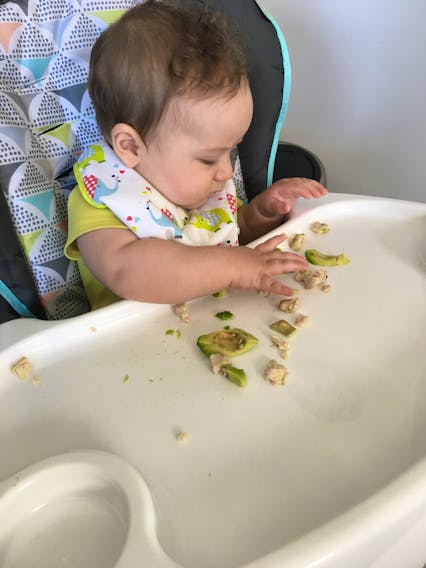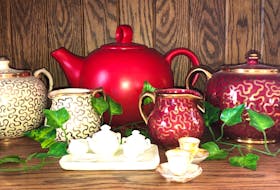Best practices for feeding babies and toddlers are constantly being updated as new research emerges, and it can sometimes be difficult to know exactly what to feed your child, when to do so and how to do it.
When possible, exclusive breastfeeding is recommended for healthy term infants for about the first six months, says Vanessa Murphy, a registered dietician and nutrition consultant with Chances Family Centre in P.E.I.
Babies are ready to start solid foods when they show interest in eating, can sit up and lean forward, have good head control, and can turn away when they are full, says Murphy. This is usually around six months.
Solid food provides extra nutrients needed for growth and development. Iron-rich foods, essential for growth and brain development, are important as breastmilk is low in iron and a baby’s stores accumulated during pregnancy are depleted around six months, she adds.
"Start by introducing one new food at a time so you can watch for potential allergies," explains Kelly Ryan, of St. John’s, N.L. who is a certified holistic nutritional consultant and certified virtual coach helping exhausted moms who want their energy back through her Re-Energized Mama Program.
If the baby is good for three days, you can move on to a new food. After a while, you’ll have enough of a variety that you can start mixing them.

Choking hazards
Many parents are anxious about choking when introducing solid foods to babies.
Ensure the food is small enough - either puréed, mashed or cut up depending on the age - so that it isn’t a choking hazard, says Ryan.
Ryan recommends parents feed babies real food - if it comes in a package, put it back on the shelf.
For example, Ryan liked to cook a whole sweet potato for her baby and fed her child whatever the rest of the family was eating.
"You don’t need to add anything like butter or seasonings, just offer whole foods," she says.
Then put the rest in ice cube trays, freeze it, and put the cubes in baggies so that they are ready to go when needed, says Ryan. Homemade baby food, such as purees, can be stored in the refrigerator for one to two days, and in the freezer for up to three months, adds Murphy.

Baby-Led Weaning
Baby-led weaning (BLW) is a relatively recent way of introducing foods where a baby starts solids by self-feeding with soft finger foods, says Murphy. This is in contrast to the traditional spoon-feeding method of feeding purees and gradually advancing to lumpy textures and progressing to independent feeding within the first year.
Finger foods are soft-cooked foods and ripe fruits, such as cooked pasta, avocado, tofu pieces, soft-cooked meats, and pieces of cooked egg. These should be easy for baby to pick up and eat, adds Murphy.
Thandi Nagel, of the Life Love Mama blog in Greenwood, N.S., and mom to an almost two-year-old son, is a big fan of this feeding method.
"Feeding babies this way allows for them to be exposed to a variety of tastes, colours, and textures, reducing the likelihood of picky eaters. It also allows for the use of fine motor skills and is great for sensory development in all aspects," she says.
Babies learn on their own when they are still hungry or full. They learn to listen to their bodies.
“I, personally, loved it because another aspect of baby-led weaning is including the baby in family meals and making mealtime a fun bonding moment,” says Nagel.
As with other feeding methods, Nagel says to introduce babies to BLW around six months, but you want to make sure your baby can sit unassisted for the most part, is working on their 'pincer grasp' (using their thumb and pointer finger to grasp things) and is interested in the food you are eating.
Nagel says when she first started BLW, it was hilarious watching her son's face as he touched and tasted different foods.
“It can definitely be a messier way of letting your baby eat, but that just makes it more fun and takes away the pressure,” she says.
“We started with banana and mashed broccoli, pre-loaded onto spoons for him. Of course, the broccoli got everywhere, but he had a blast.”
There are great BLW social media accounts with advice, says Nagel, and there are no rules to how you to do it. You can even mix BLW with purees if that's what works for you, she says.
"As long as your baby is growing healthily there shouldn't be anything to worry about, but never be afraid to consult your doctor," she adds.
Nagel advises when starting BLW to have fun with it, and don't get too caught up at the beginning with how much your baby is eating.
"Especially when you start, babies can get most of the nutrition they need from breast milk or formula, so there's really no need to worry about how much they're actually ingesting until later," she says. "Take it slow and figure out what works for you and your family."

Which method?
Murphy says there are considerations for BLW and the traditional spoon-fed methods of feeding. First, she says, there are not enough high-quality studies on BLW to say whether or not it is the recommended approach.
Some health professionals believe there is an increased risk of choking and infants not meeting their nutrient needs for growth and development (especially iron). On the other hand, proponents of BLW method propose that babies fed using this approach are more familiar with family table foods and textures leading to optimal feeding skill development and increased acceptance of foods over time.
It's also thought that the BLW approach may mean babies could be more likely to regulate their food intake and protect their ability to eat according to hunger and fullness cues, explains Murphy.
Parents should consider all options and choose what they feel is right for their infant, says Murphy. It is well established that feeding babies in a responsive way is crucial to meet their developmental needs and to foster a healthy relationship with food.
Allergy recommendations
The Canadian Pediatric Society (CPS) now recommends introducing allergenic foods such as peanuts, eggs, shellfish, soy, wheat and sesame earlier rather than later, especially in infants at higher
risk of developing an allergy, explains Murphy. This is usually around six months old, but not before four months.
Babies are at higher risk of developing allergies if they have eczema or if there is a family of history of an allergy, says Murphy. Consulting a registered dietitian, doctor or nurse practitioner is advisable if there are concerns.
Allergenic foods can be introduced one at time after a few other foods have been introduced. There is no need to wait a certain amount of time between introductions, she says.
And, if they don’t have a reaction, parents should feed it to them several times a week so they don’t develop the allergies, says Ryan.
Be cautious, though - avoid foods like unpasteurized honey because of a potential for bacteria like salmonella, adds Ryan.
All honey products are unsafe for babies under one (including pasteurized, unpasteurized and any processed foods containing honey, such as graham crackers), says Murphy. They could cause infant botulism.
Every baby and family is unique, says Murphy, who adds that registered dietitians can help with specific questions or concerns related to the introduction of solid foods and feeding in the early years and can provide individualized guidance and care.
Go online: Learn more at
Baby-Led weaning: https://lifelovemama.com/baby-led-weaning-six-months/









